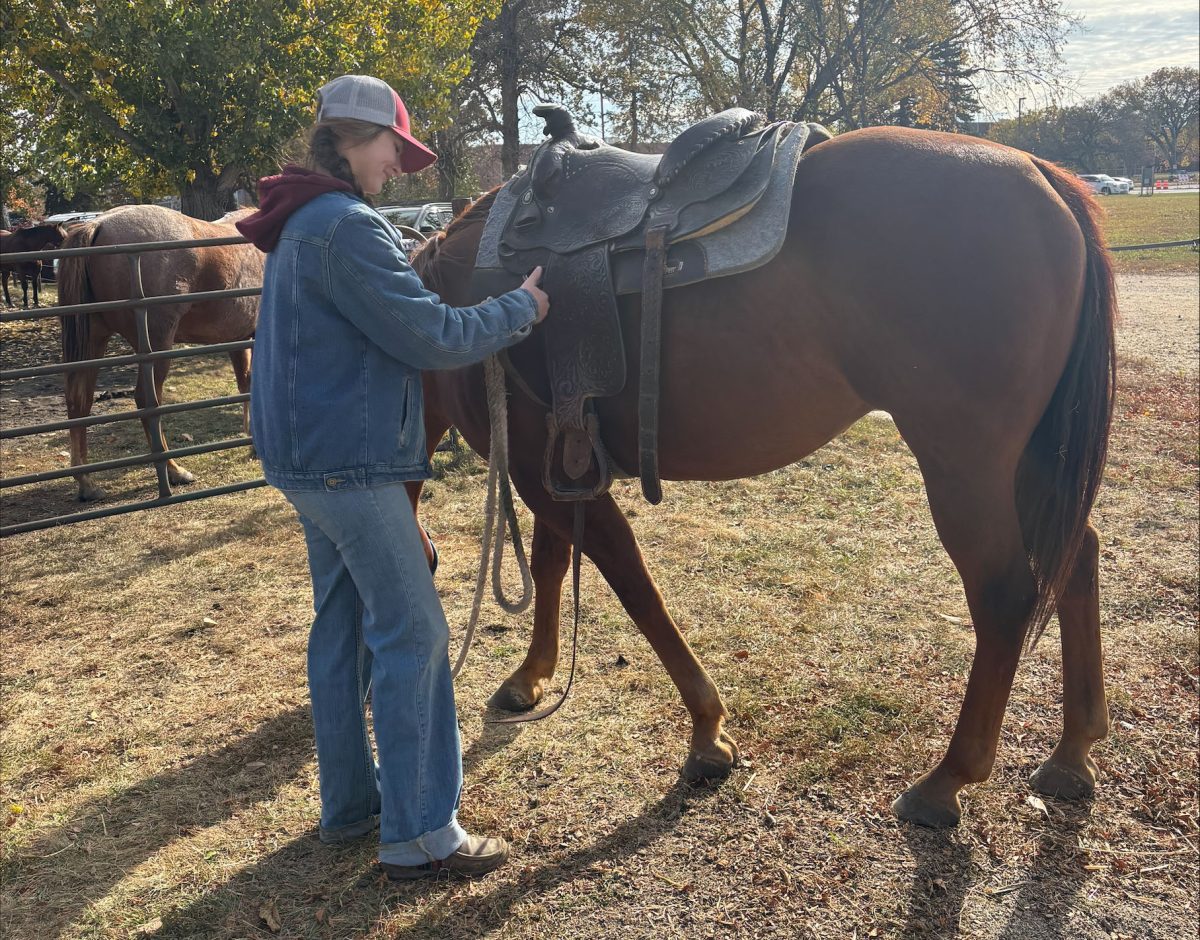When some people think of the SDSU horse unit, they might think of the rodeo or equestrian teams, but most don’t realize that a whole horse teaching and outreach facility is used to teach students about horses.
This facility, located alongside Medary Avenue on campus, holds around 60 horses, from fillies to geldings. These horses are 100% quarter horses registered with the American Quarter Horse Association, and two Belgian Draft Horse Mules are used to teach the students different types of riding. Around 10 to 12 horses are raised in the facility each year.
These horses are with students from almost the minute they are born and are around them for the rest of their lives, as their purpose is to teach students.
The students are able to interact with these horses in every stage of the horse’s life.
When a female horse (mare) is about to foal, or have her baby, two students watch a camera all day and overnight. This way, the students are able to assist with processing the colt. The students will help the newborn and the mare but then let the mare mother the foal the rest of the way. After this, they will monitor the mare and the foal to ensure everything goes smoothly.
All the mares in the breeding herd have been raised at SDSU, so the mares expect the students and staff to help with the birth.
A lab with a group of students could observe and check on the foal around two days after it is born. Dr. Carmen Paulson, an instructor for any equestrian classes at SDSU, teaches what the students need to know in the classroom.
“However we can incorporate the students and the foals into the lab, we will,” said Dr. Paulson.
She believes that students can learn about horses more by being and interacting with them than through videos because it is not easy to understand a horse through a video.
After the initial birth of the foal it will be used throughout classes for most of its life.
Although students in classes interact with the horses throughout the year, student workers also work with the horses to ensure that the horses are ready to work with the students.
“These students help with daily care like feeding, set up and help with labs, and keep the facility clean and maintained,” Jenn Eide, the horse unit manager, said. “They help provide care and assistance with foaling, along with starting colts to ride, teaching basic ground and saddling skills and wrangling escaped donkeys.”

Annabelle Hlavac and Hadleigh Hoos are just two of the many students who have made the horse unit their home.
Hlavac is a senior majoring in animal science production management with minors in equine studies and ag business and has been working at the facility for two years.
She has always been passionate about working with horses but was never given the chance. When an opening in the horse facility became available, she jumped at the opportunity without hesitation.
Hoos is a sophomore majoring in animal science production, working on an ag law certificate and minoring in criminal justice.
Unlike Hlavac, Hoos worked on a ranch back home and was looking for something to make her feel more at home, leading her to the horse facility.
One of the big advantages Hoos has found working at the facility is that doing chores has served as an outlet for her after a hard day at school.
“This place feels like a second home,” both Hlavac and Hoos said.
There are three groups of horses on campus:
• SDSU’s Equine Teaching Facility where students interested in studying animal science or choosing a minor in equine studies can learn more about horses.
• SDSU’s Equestrian Team is associated with the athletic department but has its horses separate from the unit.
• SDSU’s Rodeo Team is affiliated with the National Intercollegiate Rodeo Association and has horses separate from the unit.
These departments keep their animals separated for disease prevention and due to the high-level training required for both the equine and rodeo teams.
SDSU’s Equine Facility tries to involve the community and SDSU students as much as possible with the horses. They hold events throughout the school year and in the summer.
During the summer, they hold programs through the Brookings Park and Rec, where students can interact with the horses.
Throughout the year, an event called Horses with Heroes allows veterans to interact with the horses. The facility provides horses for Little International and hosts the State FFA Horse Career Development Event contest. The unit also holds horse sales where bidders can purchase trained horses from the university.
The campus horse club holds an open house at the horse facility in the fall of each year to allow students and community members to see the horses. They also hold a petting zoo. At this petting zoo, people can donate monetary donations to the humane society and food donations to the Brookings County Food Pantry.
To learn more about the petting zoo that the horse club put on this year, see the Collegian story online titled “Horse Club’s Petting Zoo draw large crowd.”



















